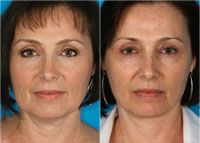- Case-Based Roundtable
- General Dermatology
- Eczema
- Chronic Hand Eczema
- Alopecia
- Aesthetics
- Vitiligo
- COVID-19
- Actinic Keratosis
- Precision Medicine and Biologics
- Rare Disease
- Wound Care
- Rosacea
- Psoriasis
- Psoriatic Arthritis
- Atopic Dermatitis
- Melasma
- NP and PA
- Skin Cancer
- Hidradenitis Suppurativa
- Drug Watch
- Pigmentary Disorders
- Acne
- Pediatric Dermatology
- Practice Management
- Prurigo Nodularis
- Buy-and-Bill
Article
Laser lipolysis offers unique benefit for jawline, midface rejuvenation
A 1,444 nm Nd:YAG lipolysis laser (AccuSculpt, Lutronic) represents a safe and effective treatment modality known as laser-assisted facial contouring (LAFC), said J. David Holcomb, M.D., at 2010 Laser, the 30th annual American Society for Laser Medicine and Surgery conference.

Key Points
Phoenix - A 1,444 nm Nd:YAG lipolysis laser (AccuSculpt, Lutronic) represents a safe and effective treatment modality known as laser-assisted facial contouring (LAFC), said J. David Holcomb, M.D., at 2010 Laser, the 30th annual American Society for Laser Medicine and Surgery conference.

According to Dr. Holcomb, there was an initial learning curve, and the treatment protocol was adjusted after the first six months based on findings from simultaneously performed laboratory and clinical studies in an effort to minimize prolonged inflammatory edema, which occurred in a few patients.
"LAFC using this particular wavelength holds promise for creating a new paradigm for facial sculpting and rejuvenation. The treatment allows for selective tissue removal to afford greater precision in three-dimensional facial contouring, while simultaneously enabling substantial skin tightening via a novel, direct subdermal approach to energy delivery," Dr. Holcomb says.

Current protocol
The current protocol for LAFC with the 1,444 nm laser consists of five steps, beginning with a field block and infiltration of small volumes of anesthetic solution (2 cc in the midface and 3 cc in the jawline) using a 1.6 mm multiport infiltration cannula.
"Only small amounts of anesthetic solution are delivered, since introducing too much water might negate the fat absorption advantage of this wavelength," Dr. Holcomb says.
The next step is laser-induced lipolysis using a bare fiber introduced 2 mm to 4 mm below the skin surface. After the fat liquefaction is completed, about 3 cc of room- temperature normal saline is injected to flush the tissue.
"The normal saline provides both a cooling effect and optimizes the results achieved with the following microlipoaspiration step," Dr. Holcomb says.
Microlipoaspiration is performed using a 19 g cannula with three ports that are offset to minimize any possibility of tissue grooving. Typically, total volumes removed range from 0.5 cc to 3 cc in the midface and between 1 cc and 4 cc in the lower face and jawline, although larger volumes are aspirated in select patients with heavier features.
Finally, deep-dermal soft-tissue coagulation is performed by angling the fiber optic tip so that it is engaged in the subdermis and then pulled along in a linear, fanlike motion.
"This step is a unique, direct approach to targeting dermal collagen, because it does not rely on passive heat transfer through the fat into the dermis," Dr. Holcomb says.
"Immediately after this step is completed, there is noticeable decrease in tissue distensibility."





